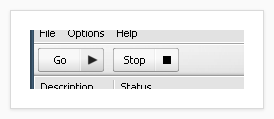
| It is simply a folder cloning utility. Point it at a pair of folders and it will make sure the second folder is always exactly like the first one. Do I see a puzzled expression on your face? "Not a rocket science" you say? | ||||

| Bvckup's default mode of operation is to constantly monitor for changes. Once the changes are detected, it propagates them to the destination. This makes Bvckup a real-time backup utility. Its default copying mode is delta copying. Which is a fancy way of saying that it copies only changed parts of each modified file. This makes Bvckup fast, really fast. Details on why delta copying is the best thing since sliced bread, how it works and when it breaks, see here - delta copying explained. Bvckup is a *backup* utility and it makes full use of this fact. By default it assumes that the destination copy does not change between the backups. This allows it to skip scanning the destination and detect changes by looking at a locally saved state from the last backup. I hear you say - bah, so what? Two words - network backups. Not needing to scan the destination eliminates a lot of network traffic and it also helps to avoid spin-ups of otherwise idle disks on NAS devices. This adds up to some major time savings, on top of those delivered by delta copying. | ||||

The ever ubiquitous user interface. It is not about utilizing all 16
million colors in a single toolbar icon. Verbosity is not a feature
and a multitude of options is not a convenience. Properly designed
user interface is all about simplicity and unobtrusiveness of the
day-to-day interaction flow.
A small example would probably go a long way here: This is the Bvckup toolbar in its entirety. Exactly two buttons. If the
backup is running, click on Stop to pause it. Click again - to cancel,
click again - to disable. Click on Go to reverse the actions.
Bvckup is as much about the UI design as it is about technical
features. In fact, if it were not for the need of a good UI, I would
have never bothered to write the program in the first place -
Short history of Bvckup.
PS. There might be some screenshots on the Screenshots page.
This is the Bvckup toolbar in its entirety. Exactly two buttons. If the
backup is running, click on Stop to pause it. Click again - to cancel,
click again - to disable. Click on Go to reverse the actions.
Bvckup is as much about the UI design as it is about technical
features. In fact, if it were not for the need of a good UI, I would
have never bothered to write the program in the first place -
Short history of Bvckup.
PS. There might be some screenshots on the Screenshots page.
| ||||

|
Bvckup is small and very lean. The installation package is about
480 KB, the program file itself is 350 KB. That's as large as
a splash screen of some other backup products :)
The app is written in C++ but without any extensive use of ++ features.
It's much more like C with Classes... just like Bjarne envisioned
before he got sucked into that bloody language design committee... but
I digress.
Very light on requirements - Bvckup installs no drivers or services,
requires no reboots and, with an exception of Volume Shadow Copying,
needs no administrative priveleges to function.
It is technically sophisticated. It doesn't copy just the
file contents and the attributes, but also the timestamps,
NTFS security and ownership information.
If it finds a file that it cannot copy (locked, open, etc), it will
try and use Volume Shadow Copying to work around the problem.
If it cannot use Shadow Copying because it is running under
a restricted administrative account, it will prompt and offer to
elevate itself to full admin privileges.
Also - and this is for true Windows connoisseurs only - Bvckup
can run in elevated and filtered modes using the same executable.
The even more amazing feat is that the very same executable can
interact with Shadow Copying service on both XP and W7.
The root of this amazingness lies, of course, in the fact that
Microsoft VSS library for XP will plainly crash on W7 and
the W7 library will return the favour if used on XP.
Stuffing both these libraries into a single executable took some
creative bit twisting, I will tell you that :)
| ||||

Assorted bits and pieces of some interest:
| ||||

|
I hope you got the general idea what this program is, and what the design approach behind it was. Take it for a spin and let us know what you think. | ||||